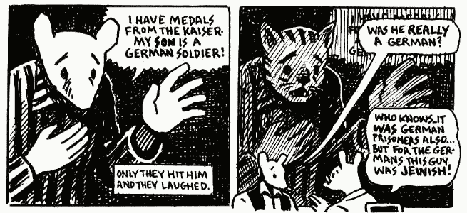Maus is an incredibly interesting work done in the style of a
graphic narrative. It depicts the life, trials, and tribulations of the author’s
father alternating between the time periods of before, during, and after the
Holocaust. The art created this comic
over the span of 13 years of interviews with his father. He wanted to
immortalize his fathers history into an
biographical graphic narrative The novel is over all very symbolic and overly
simplistic, It’s unique in that it illustrates German Nazi’s as cats and Jews
as mice., but it works in the sense that there’s seemingly no difference from
the way cats treat mice and the way Nazi Germany treated Jews. Different
animals represent other races/nationalities, and it kind of exposes the wrong
in labeling different people. It
visually simplifies the relationships between races and different people
I
enjoyed the execution and style of the graphic novel very much. The heavy line
work and graphic shapes and shading, as well as the designs of the characters
were very appealing. It is so appropriate for the historic moment and story
that it is telling. It is bold, dark, which fit the subject mater perfectly.
The narrative follows and
retells his life story as he goes through different cities in countries in Europe
and eventually ends up in the Auschwitz concentration camp. Another large part
of the story takes place in New York. I think it is very interesting that he
tires to show the differences between his father’s personality today and who he
was 50 years ago before the Holocaust. He notes the hypocrisy in his father’s
attitude of being critical toward gay people and African Americans, even after
what he’s been through. Another part of me thinks that what he’s been through
has actually served to reinforce those thoughts or behaviors. Art also notes
how his personality is now stingy, making his close ones’ lives difficult.

